India
Population: 1 Billion
Capital: New Delhi
Time Zone: GMT +5
Part of my 2006 World Trip, arriving from the United Kingdom and going on to Hong Kong.
From the mayhem of Old Delhi to the serenity of the Himalayas and the teachings of the Dalai Lama, India has to be the most interesting place I have visited.
Use the navigation bar on the left or the map-links to select a place. Alternatively scroll down to see all the entries. Click on photos to enlarge. See all India photos here.
Delhi
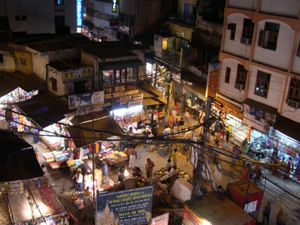 My world trip began on a warm, sweaty, night in India. The plane touched down in New Delhi around 3 am and, after an hour passing through an immigration area with signs informing me that bribery was not accepted, I found my pre-booked taxi and headed off. Even leaving the airport was something of an experience, 10 lines of cars trying to fit through a single gate, with the large amounts of horn blasting and general chaos that quickly becomes the norm anywhere you go in India. My hotel was located in the Paharganj area of Delhi (picture) where all the budget accommodation is, and one of the busiest areas of this manic city. Due in part to the greater than expected culture shock, and in part due to the hotel seeing me as an easy target to make a little money, when I surfaced the first morning, I was persuaded to signed up on a 5-day trip to see the key sights of Delhi and the Golden triangle. Initially I was annoyed with myself for allowing this to happen but later realised this was a good way to begin my travels - I had originally planned to be heading out Nepal, but several days before my flight an increase in Maoist violence there had led to all tours being cancelled and the government advising against travel.
My world trip began on a warm, sweaty, night in India. The plane touched down in New Delhi around 3 am and, after an hour passing through an immigration area with signs informing me that bribery was not accepted, I found my pre-booked taxi and headed off. Even leaving the airport was something of an experience, 10 lines of cars trying to fit through a single gate, with the large amounts of horn blasting and general chaos that quickly becomes the norm anywhere you go in India. My hotel was located in the Paharganj area of Delhi (picture) where all the budget accommodation is, and one of the busiest areas of this manic city. Due in part to the greater than expected culture shock, and in part due to the hotel seeing me as an easy target to make a little money, when I surfaced the first morning, I was persuaded to signed up on a 5-day trip to see the key sights of Delhi and the Golden triangle. Initially I was annoyed with myself for allowing this to happen but later realised this was a good way to begin my travels - I had originally planned to be heading out Nepal, but several days before my flight an increase in Maoist violence there had led to all tours being cancelled and the government advising against travel.
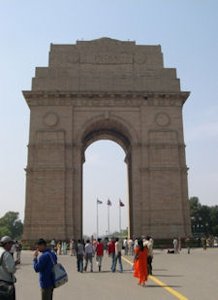 This left me with 5 weeks in India and no real plan, and this was my first experience of solo travel and my first time outside the west, so an easy start was probably what I needed. This start also allowed me to experience the worst of commission shops and quickly brought me up to speed with the required knowledge needed for solo travel on a budge. Subsequently I would meet other travellers who had also been persuaded to take tours by the same hotel, which helped as it always nice to know you are not the only one.
This left me with 5 weeks in India and no real plan, and this was my first experience of solo travel and my first time outside the west, so an easy start was probably what I needed. This start also allowed me to experience the worst of commission shops and quickly brought me up to speed with the required knowledge needed for solo travel on a budge. Subsequently I would meet other travellers who had also been persuaded to take tours by the same hotel, which helped as it always nice to know you are not the only one.
Therefore, my first day in Delhi was spent whizzing around the main tourist sites including the Red Fort, Parliament Buildings and a number of tombs as well as India Gate. Even in late February the temperature was close to 30 degrees and the sky was a cloudless blue. Below these skies, however, there just seem to be people everywhere. If not rushing from one place to another in the thousands of tuk-tuks or on the millions of bikes then they mainly seem to be loitering in the streets. I have to admit the mixture of jet-lag, culture shock and feeling of being duped by the hotel all combined and my first impressions of Delhi were on the negative side. I was lucky thought to return to Delhi a few weeks later and at this point, when I had adjusted to the life of travelling in foreign countries, I really loved the bustle of Delhi (see Delhi's 2nd Visit).
Jaipur
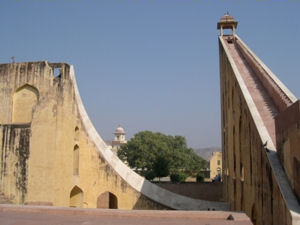 Jaipur is an amazing city stuck in the Rajasthan desert. As far as I could see there was no source of water, just vast numbers of people, large amounts of sand and a few temples. Just to the north of Jaipur is a place called Amber, the highlight of which is the Amber Fort, a place of cool serenity in the searing heat. The whole old town area is surrounded by hills on which fortified wall have been constructed and I spent the best part of a day exploring this area. Jaipur is also famed for an area called the Jantar Mantar - an ancient centre of astronomy and astrology. This houses some of the largest sundials in the world (picture), which can tell the time to an accuracy of 1 second (different to India time by about half an hour due to the time zones, as I was informed every few minutes of the tour). Besides sundials the place also has more complex star dials, which, if read correctly, can provide the information for your astrological chart tailored to the exact minute you were born.
Jaipur is an amazing city stuck in the Rajasthan desert. As far as I could see there was no source of water, just vast numbers of people, large amounts of sand and a few temples. Just to the north of Jaipur is a place called Amber, the highlight of which is the Amber Fort, a place of cool serenity in the searing heat. The whole old town area is surrounded by hills on which fortified wall have been constructed and I spent the best part of a day exploring this area. Jaipur is also famed for an area called the Jantar Mantar - an ancient centre of astronomy and astrology. This houses some of the largest sundials in the world (picture), which can tell the time to an accuracy of 1 second (different to India time by about half an hour due to the time zones, as I was informed every few minutes of the tour). Besides sundials the place also has more complex star dials, which, if read correctly, can provide the information for your astrological chart tailored to the exact minute you were born.

Jaipur is also home to the pushiest commission shops I have had the misfortune to visit. Being alone and on a tour, I was taken to a number of these places every day. You were always alone with the owner and he would spend about twenty minutes trying, often quite forcefully, to sell you stuff - it is always the best, and the cheapest, and can't be found anywhere else; and when you say no they move on to the next item or quiz you on why you do not want to buy it. Then it is their anniversary or you're the first customer of the day making it bad luck if you don't buy anything, and so it goes on (I never bought anything at any of these places and it has made me very careful about avoiding commission wherever possible). All the different guides get a cut of any money you spend, making the shops more expensive and also compulsory on all visits to different places. The guides also take you to restaurants on their list so as to again get a cut of the money you spend on food, which is ok but again more expensive and sometimes not as good as finding places yourself. At Amber I had a really good lunch of dahl and curries in one of the hilltop temples much to the dismay of my guide. It was these experiences of commission shops over the first week of my trip that toughened me up to travelling and subsequently I found all other places in the world a breeze to negotiate, hence in hindsight whilst they were not a whole lot of fun, they made the whole rest of my travels more enjoyable and so were a valuable experience.
Agra
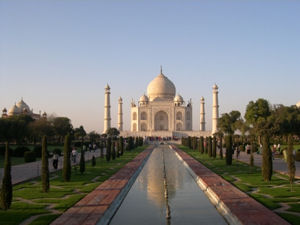 The next port of call over these busy few days was Agra. The distances between Delhi, Jaipur and Agra are all about 150 Km, but the roads are like nothing I had experienced before. Sometimes unpaved and often bumpy they were always packed with cars, lorries and motorbikes all weaving past each other and drifting either side of the road. Then there are the people and animals that takes to the roads as well making the trips slow and nerve-wracking for the first few days. A lot of time was hence spent in the taxi and I was glad to arrive finally at Agra and the Taj Mahal.
The next port of call over these busy few days was Agra. The distances between Delhi, Jaipur and Agra are all about 150 Km, but the roads are like nothing I had experienced before. Sometimes unpaved and often bumpy they were always packed with cars, lorries and motorbikes all weaving past each other and drifting either side of the road. Then there are the people and animals that takes to the roads as well making the trips slow and nerve-wracking for the first few days. A lot of time was hence spent in the taxi and I was glad to arrive finally at Agra and the Taj Mahal.
I visited close to sunset when the light was best and the colour of this majestic building changes with that of the horizon. The white marble of the main building has maintained its purity in part due to careful cleaning and also due to the banning of heavy industry in the whole Agra area some years previous. Even through it is such a big tourist attraction the Taj Mahal still feels very calm and beautiful. Built by Emperor Shah Jahan the Taj Mahal was designed to be the resting place for his queen, Mumtaz Mahal, although his son placed both bodies here instead of completing the second temple designed for the late emperor. On the hill above the town is Agra Fort, which, I felt, was more impressive than the Red Fort in Delhi although the total size is smaller. I spent a whole morning exploring the courtyards and gardens here and tried my hand at sketching - something I had planned to take up while travelling, however, a few days after this I lost my diary and then couldn't find any good paper so gave up again almost straight away and stuck to photography.
Varanasi
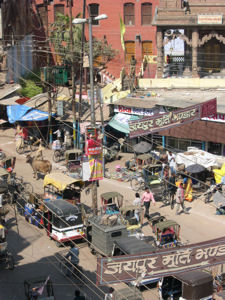 As the guide dropped me at the station, I realised this marked the end of my guided tour; I was excited to stat my solo travelling experience but also a little nervous as it sunk in that I was now very much alone in a strange country that I did not really understand. I had been stung a bit with all the commission shops over the past few days and so was a little on edge, but I quickly learned that away from this side of the tourist trade the people were really nice and very helpful.
As the guide dropped me at the station, I realised this marked the end of my guided tour; I was excited to stat my solo travelling experience but also a little nervous as it sunk in that I was now very much alone in a strange country that I did not really understand. I had been stung a bit with all the commission shops over the past few days and so was a little on edge, but I quickly learned that away from this side of the tourist trade the people were really nice and very helpful.
The trip from Agra to Varanasi was my first experience of the Indian train network, as well as my first overnight train. I was in luck; my train was on time (I met a couple at the station - incidentally Norwich City supporters - whose train was already 5 hours late). Amidst the general mayhem that surrounds a train arrival I finally found my bunk and settled down for some quite reading. Whist the bed was quite comfortable, even in the budget section, every 5 minutes the cry of 'chi' could be heard with people wandering the carriages selling tea. How a 5-minute break is enough for someone to change their mind and opt for a cup is beyond me, but this tea was certainly some of the best I have ever tried. At each station, regardless of time of night, the train was bombarded with people trying to sell almost anything; and so the night was busy and I was a somewhat exhausted by the time we pulled in to Varanasi.
Varanasi is the most holy Hindu place and the Ghats are the centre of it all. Here on the banks of the Ganges the dead are cremated and send off down river while the living bath in the holy water. Coupled with massive sewerage problems I had expected all this to produce something of a bad aroma, however, the area is really quite nice.
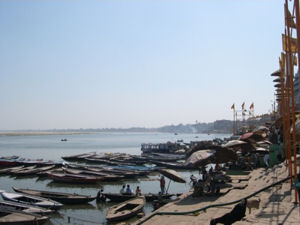
Even better, the old town area was made up of tiny street, which were fun to explore and importantly too narrow for cycle tuk-tuks; providing a rest from the continuous attention these people provide (especially to blond haired people like myself who very much stand out as a tourist). I lunched in a rather nice roof top cafe and indulged on tropical fruits while watching the noisy street scenes below. The following morning the weather was lovely and so I had breakfast in the hotel garden. I was joined by couple of other British travellers and we chatted for an hour about India and travelling. They had also just finished a tour organised by the same hotel in Delhi so we bonded over the challenges of commission shops and joys of being free from that side of travelling. This was the first real opportunity I had had to talk with some fellow backpackers and I was deeply refreshed and motivated by the encounter. After lunch I got a taxi to the stations to take another night train up to Siliguri, the furthest north the primary rail network would take me, and my gateway to the Himalayas.
Darjeeling and Surrounding Area
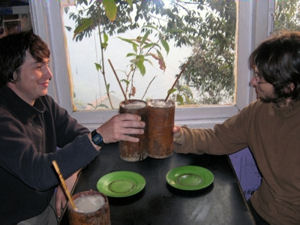 At Varanasi station I met a group of German students who were also travelling to Darjeeling; we had both decided on similar plans so I tagged along with them for the next week. The train ride from Varanasi to Siliguri was great, during the days I sat legs dangling out of the train enjoying the sun and sight of the Indian countryside passing by, I even got some sleep on the overnight stretch. The train arrived in Siliguri mid-afternoon the next day and, after some attempted bargaining (Jeep drivers operate something of a cartel, enforcing an extortionate fixed price - probably something like a few pounds), we got a Jeep to take us from the heat of the Indian plans up 2000m to the Hill Station town of Darjeeling. Travelling along the narrow roads, first through the famed tea plantations and then simply clinging to the edge of the mountains provided the first tentative views of the Himalayas - in March cloud and fog envelops the eastern mountains making visibility close to zero except in the early morning when the views are stunning. After stopping briefly at the town of Ghoom for our first taste of local tea and mu-mu (a Nepalese style Asian dumpling) we arrived in the pitch black of early evening.
At Varanasi station I met a group of German students who were also travelling to Darjeeling; we had both decided on similar plans so I tagged along with them for the next week. The train ride from Varanasi to Siliguri was great, during the days I sat legs dangling out of the train enjoying the sun and sight of the Indian countryside passing by, I even got some sleep on the overnight stretch. The train arrived in Siliguri mid-afternoon the next day and, after some attempted bargaining (Jeep drivers operate something of a cartel, enforcing an extortionate fixed price - probably something like a few pounds), we got a Jeep to take us from the heat of the Indian plans up 2000m to the Hill Station town of Darjeeling. Travelling along the narrow roads, first through the famed tea plantations and then simply clinging to the edge of the mountains provided the first tentative views of the Himalayas - in March cloud and fog envelops the eastern mountains making visibility close to zero except in the early morning when the views are stunning. After stopping briefly at the town of Ghoom for our first taste of local tea and mu-mu (a Nepalese style Asian dumpling) we arrived in the pitch black of early evening.
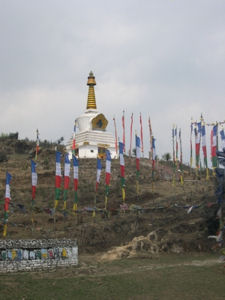 There is little electricity up in these remote places, especially on the streets, and it was unloading my stuff in this blackness that I lost my diary. After struggling up the rather sizable hill we found a cheap guesthouse and I was taught a complicated German card game. The next day we explored Darjeeling. After a fairly unexciting morning we decided to visit the zoo and mountaineering museum just outside town. Most vehicles in Darjeeling are either jeeps or Toyota minivans, the 2 types of transport able to cope with the extreme slopes; however, we manage to pick up a classic 50's American car to taxi us, who knows what it was doing in Darjeeling, but added to the joy of travelling in a new area. The zoo contained some leopard and lions all in small enclosures with concrete floors and the animals didn't seem too happy about this state of affairs. The museum on the other hand was quite good and talked mainly about the first Everest explorations.
There is little electricity up in these remote places, especially on the streets, and it was unloading my stuff in this blackness that I lost my diary. After struggling up the rather sizable hill we found a cheap guesthouse and I was taught a complicated German card game. The next day we explored Darjeeling. After a fairly unexciting morning we decided to visit the zoo and mountaineering museum just outside town. Most vehicles in Darjeeling are either jeeps or Toyota minivans, the 2 types of transport able to cope with the extreme slopes; however, we manage to pick up a classic 50's American car to taxi us, who knows what it was doing in Darjeeling, but added to the joy of travelling in a new area. The zoo contained some leopard and lions all in small enclosures with concrete floors and the animals didn't seem too happy about this state of affairs. The museum on the other hand was quite good and talked mainly about the first Everest explorations.
On the way back Stephan, Nikolas and I stopped in a cafe for a beer. This was a special beer made in the region of Sikkim - a place still hidden away in the mountains that I would still very much like to go to. The beer, if you can call it that, is fermented millet served with hot water in a bamboo mug and drunk through a bamboo straw. It tastes a lot like a dodgy homebrew so I enjoyed it very much, although the others were not so convinced. The cafe was run by a nice Nepalese guy (most people in Darjeeling are of Nepalese descent) who told us stories of Sikkim and the surrounding area while Bob Marley music played in the background. In the mountains, things are more relaxed than in the rest of India as well as cooler. Whilst I had only been travelling for a week or so it was nice to be able to take a breath and properly relaxed.
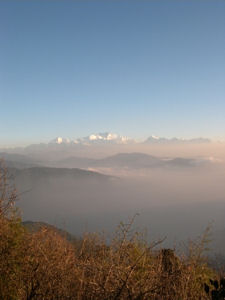 The following day we were to set off on a 4-day trek in the mountains near the India / Nepal border. Unfortunately, with daybreak I was struck down with food poisoning (fairly mild and my only case in all of Asia and most of South America). Not wishing to miss out on what looked like a great walk I opted to go anyway and hope that things would sort themselves out. The first day started by getting a Jeep to the village of Manebhanjang. From here it was only 11 Km to the hut we were going to stay, however, there was also just over one kilometre of altitude to gain, reaching just under 3000 meters. Much of the path was made up of stairs and lunch was taken near a Stupa (picture) overlooking the village we had just left. Dragging my rather cumbersome rucksack up all those steps while having to disappear into the bushes every half an hour didn't make for an overly enjoyable first days walking and I was glad to reach the hut.
To make matters worse in spring cloud sweeps up from the Indian plains making visibility poor and the afternoons bitterly cold with continuous freezing winds. But one can't complain when walking in the Himalayas; after all, it's part of the experience. The following morning the cloud had sunk into the valley and we were treated to our first spectacular view of Kangchendzonga, the world's third highest mountain. The mountain hut was basic but comfortable, if on the cold side, but the owner was really nice and cooked dinner and breakfast for us. Like all people on this trek, he was a farmer and used tourism to top up his income.
The following day we were to set off on a 4-day trek in the mountains near the India / Nepal border. Unfortunately, with daybreak I was struck down with food poisoning (fairly mild and my only case in all of Asia and most of South America). Not wishing to miss out on what looked like a great walk I opted to go anyway and hope that things would sort themselves out. The first day started by getting a Jeep to the village of Manebhanjang. From here it was only 11 Km to the hut we were going to stay, however, there was also just over one kilometre of altitude to gain, reaching just under 3000 meters. Much of the path was made up of stairs and lunch was taken near a Stupa (picture) overlooking the village we had just left. Dragging my rather cumbersome rucksack up all those steps while having to disappear into the bushes every half an hour didn't make for an overly enjoyable first days walking and I was glad to reach the hut.
To make matters worse in spring cloud sweeps up from the Indian plains making visibility poor and the afternoons bitterly cold with continuous freezing winds. But one can't complain when walking in the Himalayas; after all, it's part of the experience. The following morning the cloud had sunk into the valley and we were treated to our first spectacular view of Kangchendzonga, the world's third highest mountain. The mountain hut was basic but comfortable, if on the cold side, but the owner was really nice and cooked dinner and breakfast for us. Like all people on this trek, he was a farmer and used tourism to top up his income.
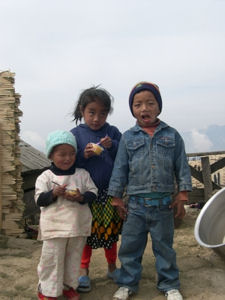 This non-dependence on the tourist trade, along with only a relatively small exposure, leads to a feeling of actually seeing local people going about their daily lives. Nowhere else in the world have I felt this - it is always a tourism orientated 'what we want to see' for a price mentality.
This non-dependence on the tourist trade, along with only a relatively small exposure, leads to a feeling of actually seeing local people going about their daily lives. Nowhere else in the world have I felt this - it is always a tourism orientated 'what we want to see' for a price mentality.
On the second day my stomach has all but sorted its self out and with blue skies and higher spirits I started to really enjoy myself. Today was fairly easy-going walking along a ridge just inside the Nepalese border, but by 3:00 the cloud had enveloped us and a gale was blowing. Rather than push on we had no choice but to stop at the village where we ate our late lunch and this proved an excellent move. We popped over to the village shop/bar to pick up some candles and beer, they had neither but offered us some local whisky in rather large glasses. While consuming these, the man who appeared to be in charge of the village came over and invited us to join the wedding celebrations that were just starting over in the town hall. We, of course, accepted and went to see the bride and groom dressed in their wedding best sitting in a small shrine which had been further decorated with Christmas streamers. They were both very nice and after the introductions we were ushered down stairs to enjoy the food laid on for the event. We had arranged to eat dinner at our hut and wanted a bit of rest and so after much reassuring the village leader we would return we made our exit. To be on the safe side he came with us, explaining (in good English) about all the partying that would occur later.
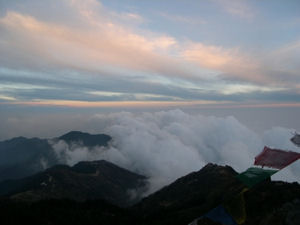 After dinner and a rest, he reappeared and after giving me a quick massage (blond hair always gets attention) we went back to the hall. Here, a stereo had been set up and was blasting modern Nepalese pop songs. We were giving local wine - really good - in large quantities. Along with a group of four other hikers who were also doing the same hike, we joined in a dancing competition. This consisted of groups of 4 getting up and dancing to songs and then the village elders chose one person from each group to go through to the next round. This continues until there was a final winner.
Alas, I didn't go through although Nikolas went a few rounds and a French guy from the other group made it to the final. I chatted (again most people know good English even in these remote places) to a few locals about football and the Maoist movement - apparently a few Maoists visit the village every year and the villagers are nice to them and they go away.
A village five miles away was less polite and a few people got killed! This was all said in very matter-of-fact way as I guess it is normal for them.
After dinner and a rest, he reappeared and after giving me a quick massage (blond hair always gets attention) we went back to the hall. Here, a stereo had been set up and was blasting modern Nepalese pop songs. We were giving local wine - really good - in large quantities. Along with a group of four other hikers who were also doing the same hike, we joined in a dancing competition. This consisted of groups of 4 getting up and dancing to songs and then the village elders chose one person from each group to go through to the next round. This continues until there was a final winner.
Alas, I didn't go through although Nikolas went a few rounds and a French guy from the other group made it to the final. I chatted (again most people know good English even in these remote places) to a few locals about football and the Maoist movement - apparently a few Maoists visit the village every year and the villagers are nice to them and they go away.
A village five miles away was less polite and a few people got killed! This was all said in very matter-of-fact way as I guess it is normal for them.
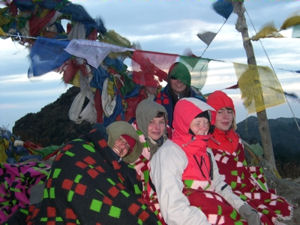 The following morning, we went to say our farewells and give the newlyweds gifts in the form of some money. Again we were given sweets and the children got very excited about seeing themselves on the digital cameras. It was only a morning walk today although very steep and quite tough, perhaps not helped by the alcohol consumed the previous night. However, we arrived at Sandakphu for a late lunch and were given a morning of excellent views. We stayed in the hut of a man we had met the night before and were joined by the other four walkers along with an elderly couple in their 70's. The afternoon was spent exploring the peak and watching the cloud come over the lower ridges. We then climbed to the highest point to watch the sunset.
This was bitterly cold and even after a beer or two we needed all the blankets available. While sunset is nice, sunrise is much more important - in Darjeeling buses are run out to a place called Tiger Hill where you can enjoy the sunrise in large bandstand along with several hundred other people - out at Sandakphu things were a little quieter (just me) and out of the clouds the views are much more spectacular. In theory Everest is visible from here, although only a spec between other peaks and at such a distance we never got sufficient visibility. But with Kangchendzonga looming so close this was wasn't of great importance.
The following morning, we went to say our farewells and give the newlyweds gifts in the form of some money. Again we were given sweets and the children got very excited about seeing themselves on the digital cameras. It was only a morning walk today although very steep and quite tough, perhaps not helped by the alcohol consumed the previous night. However, we arrived at Sandakphu for a late lunch and were given a morning of excellent views. We stayed in the hut of a man we had met the night before and were joined by the other four walkers along with an elderly couple in their 70's. The afternoon was spent exploring the peak and watching the cloud come over the lower ridges. We then climbed to the highest point to watch the sunset.
This was bitterly cold and even after a beer or two we needed all the blankets available. While sunset is nice, sunrise is much more important - in Darjeeling buses are run out to a place called Tiger Hill where you can enjoy the sunrise in large bandstand along with several hundred other people - out at Sandakphu things were a little quieter (just me) and out of the clouds the views are much more spectacular. In theory Everest is visible from here, although only a spec between other peaks and at such a distance we never got sufficient visibility. But with Kangchendzonga looming so close this was wasn't of great importance.
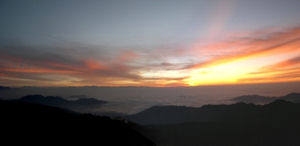 Today I was torn between heading back or joining the other four walkers who were continuing on around the ridge for a few more days. By now I was in need of a rest and so opted to head back and enjoy Darjeeling for a few days. This turned out to be a good move as I met one of the girls a few days later who said they were caught in a blizzard and snowed in for a day then had to walk back in truly miserable weather. Luckily, we had a nice walk back through forested hillsides down to the town of Rimbik. It was a long way, not helped by each local we met throughout the day explaining it was only about another half hour away (this became 5 minutes away when we were an hour from town - I guess they walk a lot faster than us).
Today I was torn between heading back or joining the other four walkers who were continuing on around the ridge for a few more days. By now I was in need of a rest and so opted to head back and enjoy Darjeeling for a few days. This turned out to be a good move as I met one of the girls a few days later who said they were caught in a blizzard and snowed in for a day then had to walk back in truly miserable weather. Luckily, we had a nice walk back through forested hillsides down to the town of Rimbik. It was a long way, not helped by each local we met throughout the day explaining it was only about another half hour away (this became 5 minutes away when we were an hour from town - I guess they walk a lot faster than us).
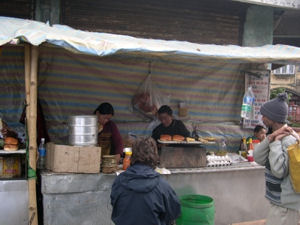 We had missed the last Jeep back to Darjeeling so started looking for a place to stay. Everywhere was rather pricey then luckily, we found driver prepared to take us back to Darjeeling. And so, began the scariest ride of my life. The roads in this part of the world are uneven tracks that only 4x4 Jeeps can tackle, strew with boulders and pits. The roads also have to somehow transport the user up or down what appears to be impossible steep mountainsides that drop into deep gullies. To do this they switch back every hundred meters and are perched right on the mountains edge - one false move and the jeep is history you think as you're bounced around all over the place. And so, with this in mind, watching the driver hurl down these tracks and around these narrow bends as fast as he could, it is a little disconcerting when he starts smoking with one hand then tried to use a mobile phone as well! The situation got worse as the sun set plunging us into complete darkness... Of course it is in the driver's interest not to drive off the edge and so he didn't, and I'm quite glad of that. I was also glad of a hot shower and a (relatively) warm place to sleep when we got back to Darjeeling.
We had missed the last Jeep back to Darjeeling so started looking for a place to stay. Everywhere was rather pricey then luckily, we found driver prepared to take us back to Darjeeling. And so, began the scariest ride of my life. The roads in this part of the world are uneven tracks that only 4x4 Jeeps can tackle, strew with boulders and pits. The roads also have to somehow transport the user up or down what appears to be impossible steep mountainsides that drop into deep gullies. To do this they switch back every hundred meters and are perched right on the mountains edge - one false move and the jeep is history you think as you're bounced around all over the place. And so, with this in mind, watching the driver hurl down these tracks and around these narrow bends as fast as he could, it is a little disconcerting when he starts smoking with one hand then tried to use a mobile phone as well! The situation got worse as the sun set plunging us into complete darkness... Of course it is in the driver's interest not to drive off the edge and so he didn't, and I'm quite glad of that. I was also glad of a hot shower and a (relatively) warm place to sleep when we got back to Darjeeling.
The following few days were spend relaxing in Darjeeling, exploring the town and surrounding area. A favourite haunt for lunch was a small stall along the market street that served excellent fried egg rolls with plenty of chilli. From here I prepared for the next step of my travels around northwest India. This started with a monster 36-hour train ride right across the north of India back to Delhi. This I planned a little badly as the day I travelled was the Holi festival of colours. This is a day where everybody goes wild and throws coloured paint at one another, something I experienced from the inside of a train, perhaps the best place to be.
Delhi's Second Visit
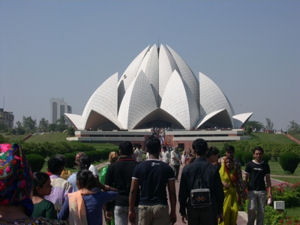 This time upon arrival in Delhi I was prepared. My friend, Vijay, works at the Indian Institute of Technology and I had arranged to meet him and stay at the university guesthouse. I easily negotiated the swaths of taxi drivers and picked up a tuk-tuk out of town to the more relaxed area of New Delhi. The guesthouse was very nice and a big thanks should be extended to Vijay and his wife who provided me with much useful information on Delhi and India as a whole, and cooked me great food over the next few days. Now accustom to the life of travelling I was happy to catch the local bus around Delhi and see some other the other sights I had missed on my first visit. The first of these was the Lotus temple (picture). This is a fine building, although I am still a little hazy about the precise religion it represents - and this is after a 15-minute chat with a missionary there! It also has a sizable park to the rear, and this is surprisingly tranquil considering the proximity to the centre.
This time upon arrival in Delhi I was prepared. My friend, Vijay, works at the Indian Institute of Technology and I had arranged to meet him and stay at the university guesthouse. I easily negotiated the swaths of taxi drivers and picked up a tuk-tuk out of town to the more relaxed area of New Delhi. The guesthouse was very nice and a big thanks should be extended to Vijay and his wife who provided me with much useful information on Delhi and India as a whole, and cooked me great food over the next few days. Now accustom to the life of travelling I was happy to catch the local bus around Delhi and see some other the other sights I had missed on my first visit. The first of these was the Lotus temple (picture). This is a fine building, although I am still a little hazy about the precise religion it represents - and this is after a 15-minute chat with a missionary there! It also has a sizable park to the rear, and this is surprisingly tranquil considering the proximity to the centre.
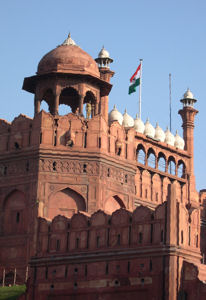 I also re-visited the Red Fort and was surprised by the much-increased level of security; this was, however, after the Varanasi bombing (which I was fortunate enough to miss by a day and only found out about from my parents a week later). It was waiting for a bus here that I experience the only (mild) hostility on my entire trip. I was sitting at the bus stop as evening was drawing near when a gang of about 6 kids approached me. They were only between about 8 and 16 and seemed harmless enough. After a chat about cricket one informed me that his friend had a knife and was 'very dangerous'. I greeted this with the usual smile and 'that's nice' and after standing around for a while they got bored and left; after, of course, all asking for money, to which the answer is always no. They didn't actually appear threatening and it is only when I realise that this was the only time anything even slightly untoward really happened me throughout the whole trip that I realised how safe the world really is (if you have some common sense).
I also re-visited the Red Fort and was surprised by the much-increased level of security; this was, however, after the Varanasi bombing (which I was fortunate enough to miss by a day and only found out about from my parents a week later). It was waiting for a bus here that I experience the only (mild) hostility on my entire trip. I was sitting at the bus stop as evening was drawing near when a gang of about 6 kids approached me. They were only between about 8 and 16 and seemed harmless enough. After a chat about cricket one informed me that his friend had a knife and was 'very dangerous'. I greeted this with the usual smile and 'that's nice' and after standing around for a while they got bored and left; after, of course, all asking for money, to which the answer is always no. They didn't actually appear threatening and it is only when I realise that this was the only time anything even slightly untoward really happened me throughout the whole trip that I realised how safe the world really is (if you have some common sense).
By chance the people I was sharing the guesthouse with were in Delhi for a Nano-technology conference, and some of the people knew my work. Bizarrely on my first morning travelling when I first arrived in Delhi, I met a different group of people off to a Raman Spectroscopy conference who also knew of me. I was therefore able to have some interesting discussions over breakfast and actually got invited to give a talk down in southern India. I clearly accepted but in the end it wasn't to be, although I'm not sure how I would have fitted it in.
From Delhi I got a night bus up to McLeodganj, a place nestled in the snowy western part of the Himalayas and home to the Dalai Lama. While waiting for the bus I sampled my first McDonalds of my trip - a veggie burger of course, and got chatting to an Indian student from the Punjab region - an area I was to visit in a few week's time, who had also just bought a burger.
McLeodganj and Surrounding Area
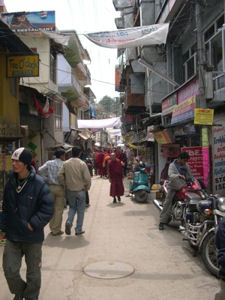 The night bus was a bus that travelled through the night. However, it could not be termed a sleeper bus since the continuous blasting of the horn and the winding of the roads up into the mountains made it impossible for me to even doze, and I was glad to arrive in Dharamsala just before daybreak. Since it was early, I decided to walk the few miles up to McLeodganj and got to witness a superb sunrise between the mountains and the plains. I breakfasted in a small Tibetan run bakery about halfway and practice my few Tibetan words on the owner. Since the arrival of the Dalai Lama in McLeodganj the place has become a mini-Tibet although quite a few Indians also live there. What I hadn't realized until my arrival in McLeodganj was that this was the start of the one fortnight in the year when the Dalai Lama performs public teachings. This was a great opportunity and again I was lucky in finding perhaps the only bed left in the whole town! It was also the cheapest; costing less that 50p a night, although was a small dorm where we shared the one bathroom with the staff and could opt of a bucket of warm water if a shower became essential.
The night bus was a bus that travelled through the night. However, it could not be termed a sleeper bus since the continuous blasting of the horn and the winding of the roads up into the mountains made it impossible for me to even doze, and I was glad to arrive in Dharamsala just before daybreak. Since it was early, I decided to walk the few miles up to McLeodganj and got to witness a superb sunrise between the mountains and the plains. I breakfasted in a small Tibetan run bakery about halfway and practice my few Tibetan words on the owner. Since the arrival of the Dalai Lama in McLeodganj the place has become a mini-Tibet although quite a few Indians also live there. What I hadn't realized until my arrival in McLeodganj was that this was the start of the one fortnight in the year when the Dalai Lama performs public teachings. This was a great opportunity and again I was lucky in finding perhaps the only bed left in the whole town! It was also the cheapest; costing less that 50p a night, although was a small dorm where we shared the one bathroom with the staff and could opt of a bucket of warm water if a shower became essential.
Due to the teachings the town was filled with bright purples and reds of the monks and there was a lively atmosphere everywhere. The first morning I wandered around the valley to a small waterfall and then in the afternoon I explored the main town. That evening I met a Finnish guy on the rooftop social area of the guesthouse. He invited me to a Mexican cafe where a Tibetan monk was giving a talk. This monk had been placed in a Chinese labour camp for 5 years for protesting against the Chinese takeover and gradual destruction of his country. Upon his release he was under strict observation and so decided, like many others, to undergo one of the most dangerous treks in the world through the Himalayas to India. This was all quite enlightening and I also learned about China's use of Tibet to do nuclear testing and dump chemical waste. The following day I signed up to go to the Teachings and met two of the other people in my dorm - Barney, an American guy, and Gabby, an Austrian girl now living in Thailand. Both were there for the teachings and I had many interesting conversations with them on life and religion.
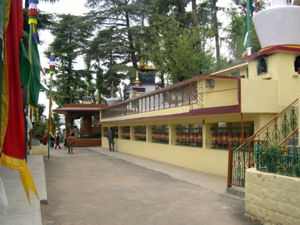 My next few days were spent going to the teachings in the mornings and walking the hills in the afternoons. The teachings were conducted in Tibetan, but were translated in real time and broadcasted over a small radio link so you could understand what was being said. There were also teachings in the afternoons and review sessions in the evenings. I went to one review session with the others, which turned out to be quite interesting and focused on more general aspects of Buddhism. I had not realized, for example, that in Tantric Tibetan Buddhism (different from the 2 main streams practiced across the rest of Asia) there are many hell realms. After each teaching the monks walk a circuit around the temple and past the Dalai Lama's house where there are many prayer wheel (picture) and small shrines, along with pray flags.
My next few days were spent going to the teachings in the mornings and walking the hills in the afternoons. The teachings were conducted in Tibetan, but were translated in real time and broadcasted over a small radio link so you could understand what was being said. There were also teachings in the afternoons and review sessions in the evenings. I went to one review session with the others, which turned out to be quite interesting and focused on more general aspects of Buddhism. I had not realized, for example, that in Tantric Tibetan Buddhism (different from the 2 main streams practiced across the rest of Asia) there are many hell realms. After each teaching the monks walk a circuit around the temple and past the Dalai Lama's house where there are many prayer wheel (picture) and small shrines, along with pray flags.
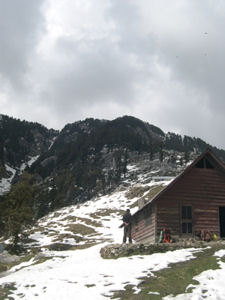 After a few days of teachings, I was itching to get out and further explore the mountains, so I set off early one morning to walk to the snow line. This was a great walk-in beautiful weather and I met up with a spiritual healer along the way and chatted about various things. The snow line was situated at Triund where there were a few small stone buildings where you could buy tea and a proper lodge for people to stay (picture). Since it was quite early in the year snow was still thick on the ground and the cafe higher up was not accessible. It was, however, only about 11:00 and I wanted to try to go a bit further. Here I met up with a guy called Paul and we set off to try to summit the ridge (from the picture, like when we were there, it doesn't look too hard). We set off along the path but this quickly turned into deep snow covering a steep slope dropping a thousand meters or more. Not really wishing to descend in record time we retraced our steps and opted to climb straight up the ridge. This started fairly easy, although the snow was often waist deep if you went the wrong way. Ever since I had left McLeodganj 2 dogs had been following me, and even in this depth of snow they continued. They were healthy and energetic and not at all interested in any food we tried to give them, they simply followed us all day. Our guess was they were trained to follow walkers to stop them getting into trouble. Our assent continued until we were traversing around narrow ledges with well over kilometre drops below us, and when it turned into climbing shear walls of rock I opted to stop. It was also getting late and a storm was approaching, plus it was pretty scary.
After a few days of teachings, I was itching to get out and further explore the mountains, so I set off early one morning to walk to the snow line. This was a great walk-in beautiful weather and I met up with a spiritual healer along the way and chatted about various things. The snow line was situated at Triund where there were a few small stone buildings where you could buy tea and a proper lodge for people to stay (picture). Since it was quite early in the year snow was still thick on the ground and the cafe higher up was not accessible. It was, however, only about 11:00 and I wanted to try to go a bit further. Here I met up with a guy called Paul and we set off to try to summit the ridge (from the picture, like when we were there, it doesn't look too hard). We set off along the path but this quickly turned into deep snow covering a steep slope dropping a thousand meters or more. Not really wishing to descend in record time we retraced our steps and opted to climb straight up the ridge. This started fairly easy, although the snow was often waist deep if you went the wrong way. Ever since I had left McLeodganj 2 dogs had been following me, and even in this depth of snow they continued. They were healthy and energetic and not at all interested in any food we tried to give them, they simply followed us all day. Our guess was they were trained to follow walkers to stop them getting into trouble. Our assent continued until we were traversing around narrow ledges with well over kilometre drops below us, and when it turned into climbing shear walls of rock I opted to stop. It was also getting late and a storm was approaching, plus it was pretty scary.
 Coming back down involved sliding and wading through the snow but it wasn't long before we dropped below the snow line and started to warm up.
I did a few other walks in the mountains over the next days and tried out most of the cakes the local bakeries the town had to offer. Tibetan food is really good, mainly consisting of noodle soups of various kinds. McLeodganj also had Spanish, Israeli and Italian restaurants and the atmosphere of the whole town was such that you would make a few friends every mealtime. In fact, after a week I was starting to feel quite at home here, bumping into old acquaintances in the street or in cafes and discussing what we had been up to the previous days along with our views on the teachings. However, in some ways the point of travelling is just that, and when there is so much else to see and do it is crazy to stay in one place for too long - I don't feel you can really fully appreciate a place when travelling, you would have to actually live there to truly make friends with local people for example, and so the difference between staying 2 days or 3 weeks is almost meaningless to me. So, the following day I caught a bus back out of the mountains down to Amritsar, capital of the Punjab region.
Coming back down involved sliding and wading through the snow but it wasn't long before we dropped below the snow line and started to warm up.
I did a few other walks in the mountains over the next days and tried out most of the cakes the local bakeries the town had to offer. Tibetan food is really good, mainly consisting of noodle soups of various kinds. McLeodganj also had Spanish, Israeli and Italian restaurants and the atmosphere of the whole town was such that you would make a few friends every mealtime. In fact, after a week I was starting to feel quite at home here, bumping into old acquaintances in the street or in cafes and discussing what we had been up to the previous days along with our views on the teachings. However, in some ways the point of travelling is just that, and when there is so much else to see and do it is crazy to stay in one place for too long - I don't feel you can really fully appreciate a place when travelling, you would have to actually live there to truly make friends with local people for example, and so the difference between staying 2 days or 3 weeks is almost meaningless to me. So, the following day I caught a bus back out of the mountains down to Amritsar, capital of the Punjab region.
Amritsar
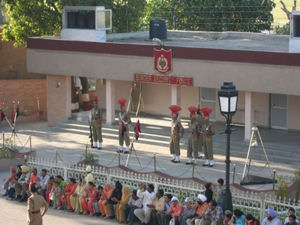 The Punjab region is one of the wealthier regions of North India, and has smooth roads along with heavy industry. Many locals had told me that Amritsar was one of their favourite places since it was clean and tidy and had traffic rules. I was incredibly lucky that the parents of one of my friends, Sumeet, live here and he had said they would put me up for a night or so.
Mr. Mahajan even came and met me at the bus station. The next few days were really enjoyable and I was cooked vast amounts of great food and was treated to a life of luxury. I also had many interesting conversations with Mr. Mahajan about India and learned much about its history and culture.
The Punjab region is one of the wealthier regions of North India, and has smooth roads along with heavy industry. Many locals had told me that Amritsar was one of their favourite places since it was clean and tidy and had traffic rules. I was incredibly lucky that the parents of one of my friends, Sumeet, live here and he had said they would put me up for a night or so.
Mr. Mahajan even came and met me at the bus station. The next few days were really enjoyable and I was cooked vast amounts of great food and was treated to a life of luxury. I also had many interesting conversations with Mr. Mahajan about India and learned much about its history and culture.
The first day Mr. Mahajan arrange a tuk tuk to take me to some of the smaller temples around the city followed by a trip to watch the closing ceremony at the India / Pakistan border. I arrived here with plenty of time so grabbed a drink and was just in time to watch England lose to India in the cricket, although everyone was very polite and told me we should have won.
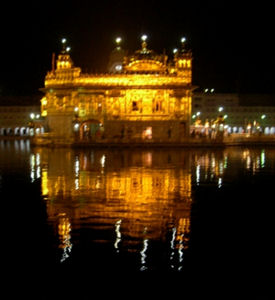
The border ceremony is performed every evening, however, the celebrations that go along with it make you feel like it's a once in a lifetime occasion. Armed with an India flag and cap I filed into a large bandstand along with several thousand other people. There was a PA system and before the ceremony itself began music was played and the announcer would shout out to get the crowd cheering; this was also being done on the Pakistan side leading to even greater levels of excitement with both sides trying to shout the loudest – it is hard to imagine that Kashmir is not far from here; people are dancing and generally having a great time. Then the soldiers started a highly elaborate ceremony, again with each side trying to kick their legs higher and generally outdo each other. This continued for some time until finally the flag was brought back, and greeted with further cheers.
That evening the family took me to the most famous sight of Amritsar - The Golden Temple. This is the most sacred place in the Sikh religion and is a stunning building. At night the central temple is lit up making it truly beautiful.
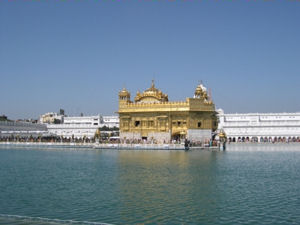 We wandered around here for a while and I was shown the sacred trees where sparrows sleep. This is a quite bizarre natural phenomenon - out of all the trees and bushes in the complex all the thousands of sparrows choose to sleep in just two trees. This makes the trees absolutely packed with birds. It is said that when the holy book is put away for the night - goes to sleep as it is considered alive - so to the sparrow come to the trees to sleep.
We wandered around here for a while and I was shown the sacred trees where sparrows sleep. This is a quite bizarre natural phenomenon - out of all the trees and bushes in the complex all the thousands of sparrows choose to sleep in just two trees. This makes the trees absolutely packed with birds. It is said that when the holy book is put away for the night - goes to sleep as it is considered alive - so to the sparrow come to the trees to sleep.
Volunteers run the whole temple and it is possible to get food and a place to sleep for free if you wish. The following day I returned and spent a good few hours here wandering the various areas. The main temple is in the centre of a small lake, and surrounding this are buildings made of pure white stone. There are then further buildings outside this, all brilliant white and immaculately clean. I watched the large open-air kitchens preparing food and then visited the central golden temple itself, something that takes queuing to a new level.
 The final place I visited in Amritsar was the park Jallianwala Bagh. This is very near the Golden Temple in the heart of the city and is quite famous for one thing. Back in 1919, during the Indian struggle for independence against the British, a peaceful meeting was being held here. The park has only exit and General Dyer of the British army brought his troops into the park and opened fire on the crowd, killing many civilians. The park now holds tribute to this with paintings and statues. It is not often that I feel so aware of being British, but here I was certainly reminded of my counties less amicable past. Even so, every so often people would come up to me and ask where I was from, I would reply England and always, even here, the response was positive, 'nice to meet you' or 'how are you enjoying our country?' This is equally true everywhere in the world but especially so around India. Having an empire such as we did, we must have committed some dreadful things but everyone seems to have forgiven this and likes the British.
The final place I visited in Amritsar was the park Jallianwala Bagh. This is very near the Golden Temple in the heart of the city and is quite famous for one thing. Back in 1919, during the Indian struggle for independence against the British, a peaceful meeting was being held here. The park has only exit and General Dyer of the British army brought his troops into the park and opened fire on the crowd, killing many civilians. The park now holds tribute to this with paintings and statues. It is not often that I feel so aware of being British, but here I was certainly reminded of my counties less amicable past. Even so, every so often people would come up to me and ask where I was from, I would reply England and always, even here, the response was positive, 'nice to meet you' or 'how are you enjoying our country?' This is equally true everywhere in the world but especially so around India. Having an empire such as we did, we must have committed some dreadful things but everyone seems to have forgiven this and likes the British.
From Amritsar I caught a fast train to Delhi and after a day wandering Paharganj I got an early morning flight to my next destination - Hong Kong.